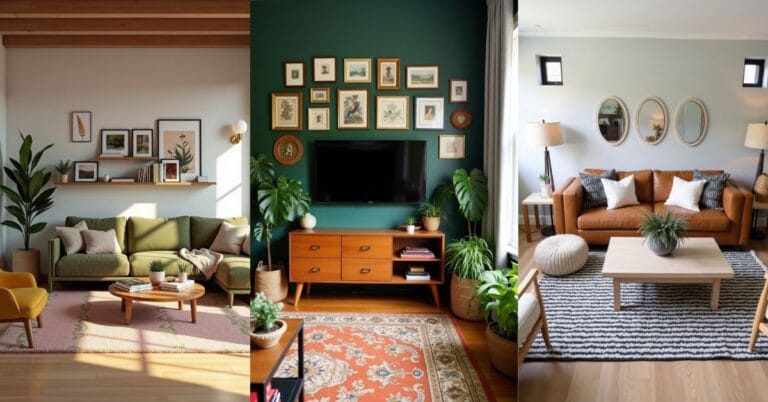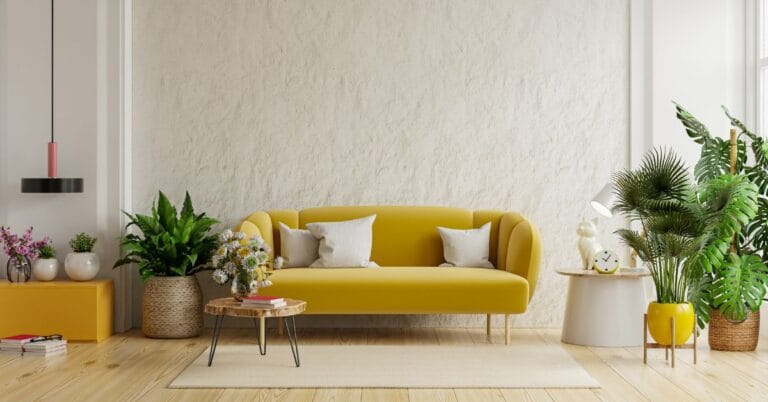How to Choose the Right Rug Size and Placement for Your Living Room
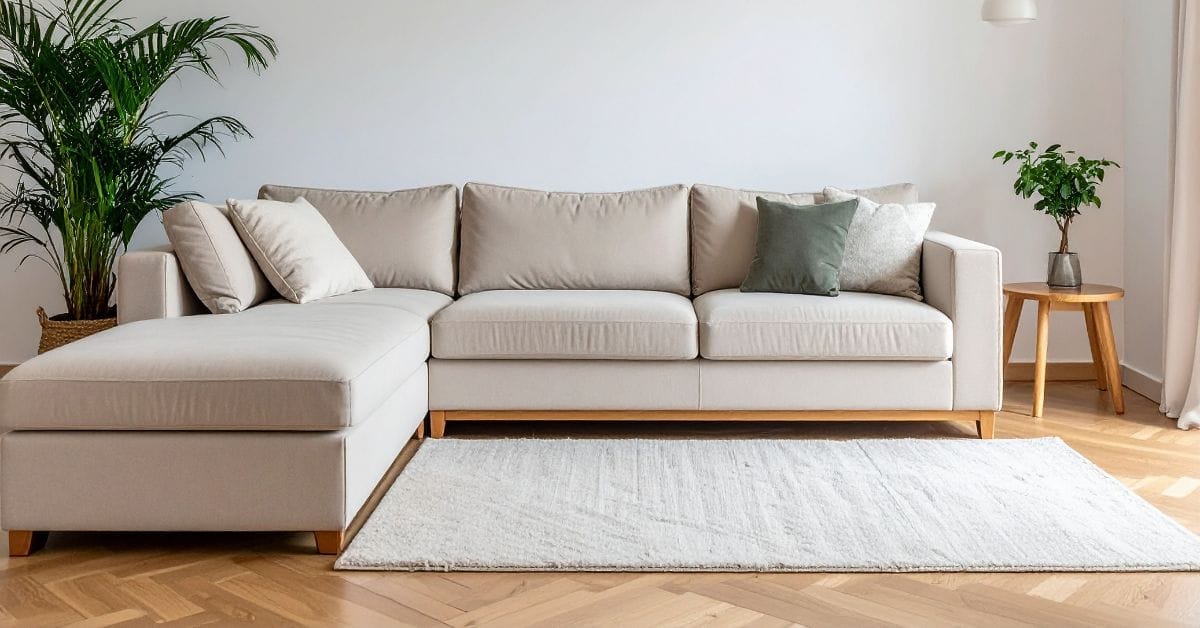
Rugs are one of those deceptively simple pieces of decor that can totally transform a room, if you get it right. But let’s be honest, figuring out the perfect size and placement can feel like trying to solve a tricky puzzle. Go too small, and your furniture looks like it’s awkwardly floating in space. Go too big, and it might feel like you accidentally rolled out wall-to-wall carpeting. We’ve all been there, staring at rug options with that “what am I even doing?” look on our faces.
The good news? There’s a method to this madness, and it’s not as complicated as it seems. Getting the rug size and placement right is all about balance and a few simple tricks. Let’s break it all down so you can pick a rug that not only fits your space but also ties your room together like it was made for it.
Why Rug Size Matters in a Living Room
Let’s be real. Rugs aren’t just something you throw on the floor to keep your toes warm. They play a starring role in how your living room looks and feels. A perfectly sized rug can tie everything together, making your furniture arrangement feel purposeful while adding warmth and style to the space. On the other hand, the wrong rug size? It can make even the most beautiful living room feel off-balance or incomplete.
Think of a rug as the anchor for your room. It defines your seating area, keeping your sofa, chairs, and coffee table from looking like they’re floating in a sea of hardwood or carpet. Whether your space is cozy or expansive, the right rug size creates a sense of unity that’s hard to achieve otherwise.
There’s also a practical side to this. A rug helps soften the acoustics of your living room, muffling noise and adding that oh-so-satisfying underfoot comfort. For open floor plans, a well-chosen rug can help carve out distinct zones, like a seating area or play space, making the layout feel intentional.
But what happens if you get it wrong? A rug that’s too small will make your furniture look disconnected and leave the room feeling unfinished. Too big, and it can overwhelm the space, throwing off the balance you worked so hard to create.
How to Measure Your Living Room for a Rug
Before you even start browsing for rugs, grab a tape measure. Knowing your space and understanding the dimensions of your seating area will make finding the right rug so much easier. Here’s how to get it right without second-guessing yourself.
First, focus on the seating area rather than the entire room. A common mistake is choosing a rug based on the room’s overall size, but that’s not what matters. Instead, measure the area where your furniture naturally groups together, typically the sofa, chairs, and coffee table. This is the space your rug needs to fit.
For a more hands-on approach, use painter’s tape to map out different rug sizes directly on the floor. This trick allows you to visualize how various dimensions will look in your living room before you commit. It’s especially helpful if you’re debating between two sizes or trying to decide on placement.
Here are a few things to keep in mind while measuring:
Taking the time to measure and plan ensures you won’t end up with a rug that looks like an afterthought, or worse, one that you’ll need to return.
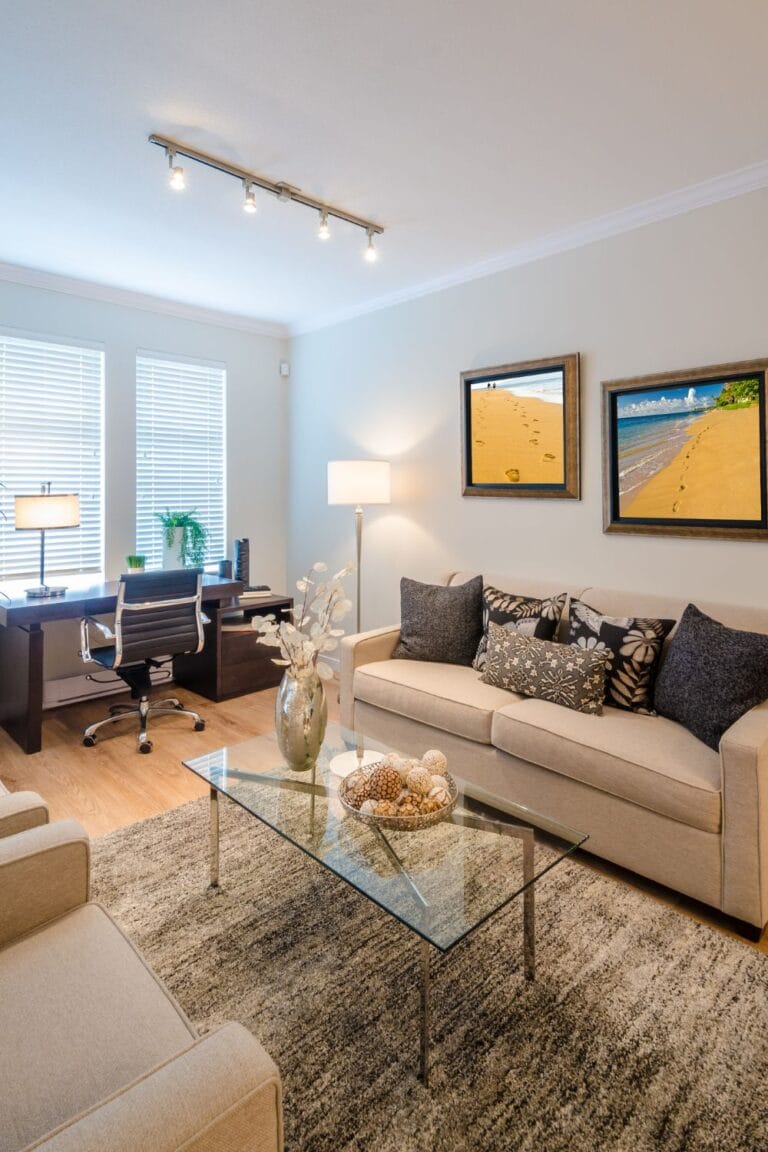
Common Rug Sizes and Where They Work Best
Let’s face it, rug shopping can feel like an overwhelming math problem. Should it be big enough for all the furniture? Just the coffee table? And why are there so many sizes? Don’t worry, we’ve got you covered. Here’s a quick breakdown of popular living room rug sizes and how to pick one that fits your space like a glove.
5 x 7 feet
This size is a lifesaver for smaller living rooms or apartments where space is limited. It’s perfect if you want a stylish accent under a coffee table or need to add a splash of texture without overpowering the room. Just make sure your furniture doesn’t dwarf the rug. It should complement the space, not disappear under it.
8 x 10 feet
The Goldilocks of rug sizes for medium living rooms. Not too small, not too large. This size is just right for most setups. You can place the front legs of your sofa and chairs on the rug to anchor the space while keeping it open and airy. It’s also a great option for rooms with two seating areas, like a sofa and loveseat combo.
9 x 12 feet
Got a larger living room? This size creates a polished, cohesive look by fitting all the furniture in your seating area comfortably. With a 9 x 12, you can go for the “all legs on the rug” layout, which is as fancy as it sounds. It gives the room a unified feel, making your space look intentional and well-thought-out.
12 x 18 feet
If your living room could double as a ballroom (lucky you), this is your go-to size. It’s designed for expansive spaces with multiple seating arrangements. Think sectional sofas, accent chairs, and coffee tables all living happily together on one massive rug. Just be sure to leave a little breathing room around the edges so your floor peeks through.
Hot Tip: When in doubt, go bigger. A rug that’s slightly oversized makes your space feel more luxurious, while one that’s too small can make the room feel cramped or unfinished.
Popular Rug Placement Styles for Living Rooms
Once you’ve nailed the rug size, it’s time to figure out where to place it. Rug placement might seem like a small detail, but trust me, it’s the difference between a room that feels effortlessly styled and one that feels a little…off. Let’s break down the three most popular ways to position a rug in your living room and why they work.
1) All legs on the rug
This placement screams polished and intentional. The rug is large enough to hold the entire seating area, with every piece of furniture, sofa, chairs, coffee table, fully resting on it. This style works best in spacious living rooms where the rug can stretch out without overwhelming the space.
Why it’s a winner: This layout creates a sense of unity, making everything feel tied together. It’s a go-to for large open floor plans or formal living rooms where you want to make a statement. Just make sure the rug leaves a bit of breathing room (12-18 inches of floor around the edges) so it doesn’t look like wall-to-wall carpeting.
2) Front legs on the rug
If you’re working with a medium-sized room or want to keep things a bit more casual, this option is a happy medium. The front legs of your sofa and chairs sit on the rug, while the back legs stay off. It defines the seating area without making it feel too closed in.
Why it works: This style anchors the furniture to the rug, giving the room a grounded and balanced look. It’s also a budget-friendly choice if you’re eyeing a smaller rug but still want the space to feel cohesive. Bonus: It leaves more floor exposed, which can help your room feel larger.
3) Coffee table only on the rug
For small spaces or minimalistic setups, this placement keeps things simple. A smaller rug goes under the coffee table, with the surrounding furniture completely off the rug.
Why it’s a good idea: This look works well in compact living rooms or when you want to highlight the coffee table as a focal point. It’s also an easy way to introduce texture or a pop of color without committing to a large area rug. Just make sure the rug is big enough to extend beyond the table’s edges for balance.
Hot Tip: Avoid the dreaded “floating rug” syndrome. You know, when a tiny rug sits in the middle of your furniture, disconnected from everything else? Always aim to have at least part of your furniture touching the rug to keep the look intentional.
Play around with these styles, and don’t be afraid to get creative. It’s your living room, after all!
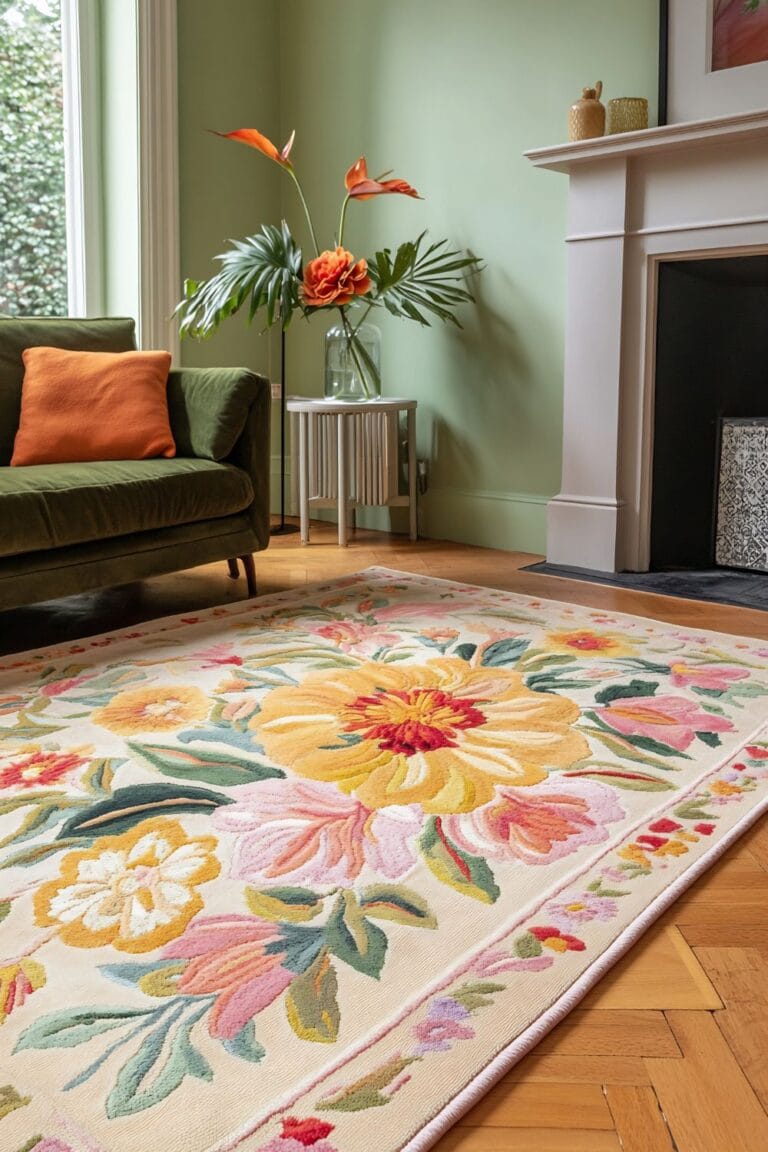
How to Choose the Right Rug for Your Furniture Layout
Your furniture layout is like a blueprint for finding the perfect rug. It tells you everything you need to know about size and placement. Whether your living room is tightly arranged or sprawled out, the rug you pick should complement how your furniture is set up and how you use the space.
a) For smaller, closer layouts
If your sofa and chairs are snugly arranged, you don’t need a massive rug to tie everything together. A smaller rug that anchors just the front legs of your furniture can work beautifully. For example, an 8 x 10 rug might be just right for keeping the seating area defined without overwhelming the room. This layout also creates a cozy, grounded vibe that works wonders in medium-sized living spaces.
b) For larger, open layouts
In bigger living rooms, the rug becomes more than a cozy accent. It’s a statement piece. A 9 x 12 or 12 x 18 rug ensures all the furniture legs fit comfortably on the rug, creating a unified look that’s perfect for expansive seating areas. This approach works especially well if your sofa and chairs are positioned further apart or you have multiple seating zones to define.
c) Leave some breathing room
No matter the size of your rug, always allow for a bit of exposed flooring around the edges, about 12 to 18 inches. This creates a balanced frame around your rug and keeps the room from feeling overcrowded. Think of it like eyeliner for your floor, just enough to highlight without taking over.
d) Match your layout to your lifestyle
If your living room sees a lot of activity (kids playing, pets lounging, or frequent entertaining), you’ll want a rug that’s both practical and well-placed. For high-traffic spaces, a larger rug can protect your floors while also providing a soft surface for everyone to gather.
Hot Tip: When in doubt, measure your seating area and map out the rug’s dimensions with painter’s tape. This simple trick gives you a preview of how the rug will fit into your layout and helps you avoid costly mistakes.
Common Mistakes People Make When Choosing a Rug
Let’s be honest, picking the perfect rug is tricky, and we’ve all made a misstep or two. But don’t worry; we’ve rounded up the most common rug mistakes so you can sidestep them with confidence.
1) Going too small
This is the most common rug faux pas, and it’s a biggie. A rug that’s too small leaves your furniture looking like it’s stranded on little islands. Instead of creating a cohesive look, the room ends up feeling disjointed and incomplete. If your sofa and chairs are spilling off the edges of your rug (or not even touching it), it’s time to size up.
2) Ignoring traffic patterns
We’ve all tripped on a poorly placed rug corner, and it’s no fun. Rugs that block natural pathways can disrupt the flow of your living room and turn into an everyday obstacle course. When placing your rug, think about how people move through the space. Is there enough clearance for chairs? Are rug edges lined up with walkways? A quick check can save you, and your guests, a lot of frustration.
3) Choosing the wrong material
Not all rugs are created equal, and picking the wrong material can lead to regret. Got kids? Pets? High foot traffic? Skip the delicate silks and opt for durable, easy-to-clean options like wool, jute, or synthetic blends. For example, wool rugs are soft and long-lasting, while synthetic rugs are budget-friendly and resistant to spills (hello, lifesaver).
4) Skipping a test run
Okay, this one’s less of a mistake and more of a missed opportunity. Before buying, map out the rug’s size with painter’s tape on your floor. It’s a simple hack to visualize how it will fit and avoid the dreaded “oops, it’s way too small” moment.
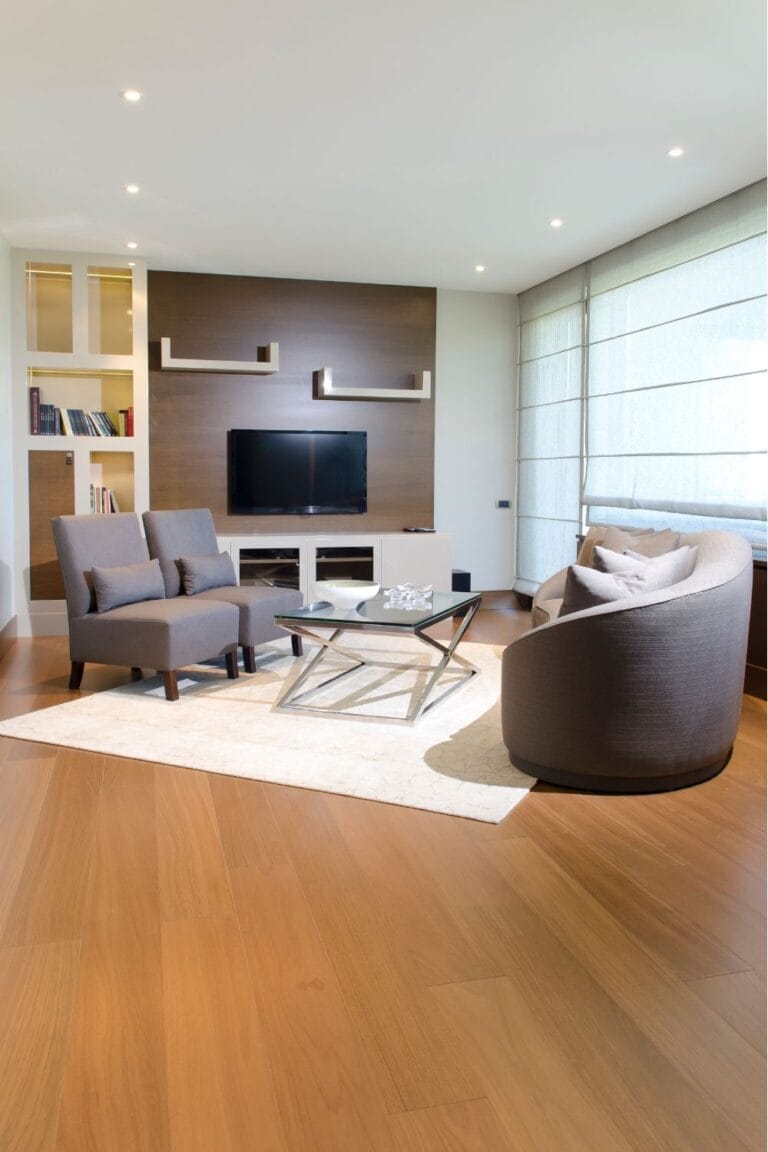
How to Balance Rug Size with Room Dimensions
Finding the perfect rug size isn’t just about your furniture. It’s also about how the rug interacts with the rest of the room. The key to creating harmony is making sure the rug complements the room’s dimensions. Think of it as framing a beautiful picture; the rug should improve the overall look, not compete with it.
a) Leave some breathing space
One simple rule of thumb: make sure there’s 12 to 18 inches of bare floor between the edges of the rug and the walls. This gives your room a well-defined look without the rug swallowing up the entire space. Too little floor exposure, and you risk making the room feel cramped.
b) Shape matters too
If your living room is long and narrow, consider a runner-style rug to enhance the shape of the room. For square spaces, a square or round rug might work better to complement the layout. Matching the rug’s shape to the room’s proportions can do wonders for the overall aesthetic.
c) Think about layering
For larger rooms, layering rugs can add depth and interest. Start with a neutral base rug that fills most of the space, then add a smaller, decorative rug on top. It’s like giving your room a little extra flair without going overboard.
Tips for Making the Best Rug Choice
Sometimes, it’s the little things that make all the difference when choosing a rug. Here are some tried-and-true tips to make your decision a whole lot easier:
1) Map it out first
Before hitting “add to cart,” grab some painter’s tape and outline the rug’s dimensions on your floor. This simple step helps you visualize how the rug will look and whether it fits your space.
2) Layering adds character
Don’t be afraid to layer. A neutral base rug with a patterned or textured accent rug on top can add visual interest and break up monotony. Plus, it’s a clever way to work with an existing rug you love but that’s slightly too small.
3) Test it virtually
Many online retailers now offer tools that let you preview how a rug will look in your room. Take advantage of these features. They can save you from second-guessing your choice later.
4) Choose low-maintenance materials
Life gets messy, so pick a rug that can handle it. Wool, synthetic blends, and indoor-outdoor materials are great for high-traffic spaces. They’re durable, easy to clean, and can handle everything from muddy shoes to pet hair.
Hot Tip: If spills are a frequent guest in your living room, consider rugs with a subtle pattern or darker tones to camouflage stains.
Bringing It All Together
Choosing the right rug for your living room doesn’t have to feel overwhelming or overly technical. It’s really about finding the sweet spot where size, placement, and style work in harmony with your space. Once you’ve nailed these details, your rug becomes more than just an accessory. It’s the piece that ties everything together and makes the room feel effortlessly pulled together.
Take your time, measure carefully, and don’t be afraid to experiment with placement or layering to see what feels best. Rugs are one of those details that might seem small but have a big impact on how your living room looks and feels. With a little planning and creativity, you’ll have a rug that not only fits but makes your space feel more inviting and uniquely yours.

